2018年人教版七年级英语(下册)教(学)案
- 格式:doc
- 大小:645.00 KB
- 文档页数:124
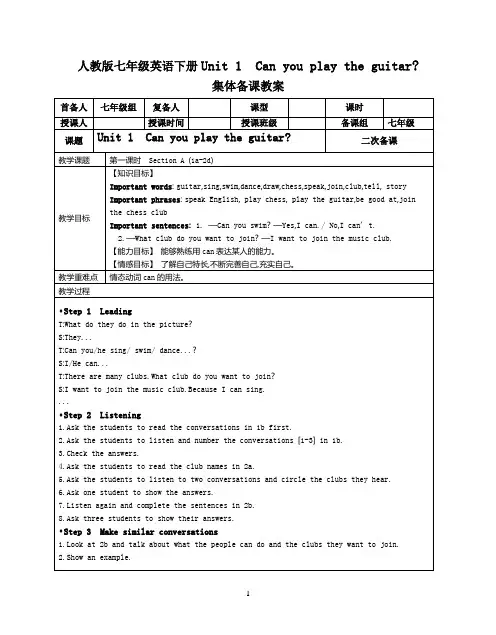
人教版七年级英语下册Unit 1 Can you play the guitar?集体备课教案人教版七年级英语下册Unit 1 Can you play the guitar?集体备课教案人教版七年级英语下册Unit 1 Can you play the guitar?集体备课教案人教版七年级英语下册Unit 1 Can you play the guitar?集体备课教案人教版七年级英语下册Unit2 What time do you go to school?集体备课教案人教版七年级英语下册Unit2 What time do you go to school?集体备课教案人教版七年级英语下册Unit2 What time do you go to school?集体备课教案人教版七年级英语下册Unit2 What time do you go to school?集体备课教案人教版七年级英语下册Unit 3How do you get to school?集体备课教案人教版七年级英语下册Unit 3How do you get to school?集体备课教案人教版七年级英语下册Unit 3How do you get to school?集体备课教案人教版七年级英语下册Unit 3How do you get to school?集体备课教案人教版七年级英语下册Unit 4Don’t eat in class.集体备课教案人教版七年级英语下册Unit 4Don’t eat in class.集体备课教案人教版七年级英语下册Unit 4Don’t eat in class.集体备课教案人教版七年级英语下册Unit 4Don’t eat in class.集体备课教案教版七年级英语下册Unit 5Why do you like pandas?集体备课教案教版七年级英语下册Unit 5Why do you like pandas?集体备课教案教版七年级英语下册Unit 5Why do you like pandas?集体备课教案教版七年级英语下册Unit 5Why do you like pandas?集体备课教案教版七年级英语下册Unit 6I’m watching TV.集体备课教案教版七年级英语下册Unit 6I’m watching TV.集体备课教案教版七年级英语下册Unit 6I’m watching TV.集体备课教案教版七年级英语下册Unit 6I’m watching TV.集体备课教案教版七年级英语下册Unit 7It’s raining集体备课教案。
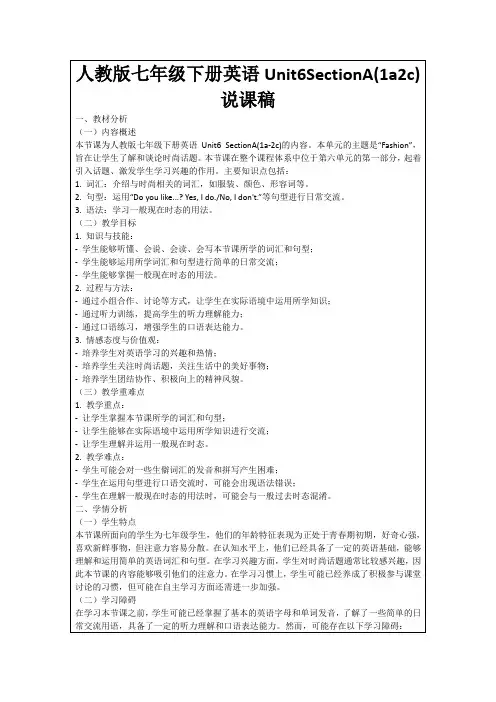

Unit 1 Can you play the guitar?导学案Period 1 Section A(1a---2c)【学习目标】:1.学会谈论自己的喜好和意愿及表达自己在某一方面所具备的才能。
2.掌握并运用各种俱乐部的短语。
3. 熟练的谈论表示能力的话题,以及自己的意愿.【学习重点】:学会谈论自己或别人的能力. 能表达自己在某一方面所具备的才能及喜好与意愿。
【学习过程】:一、自主学习合作探究(教师寄语:Many hands make light work. )学习任务一:认读并书写本课单词..写出下列单词并展示.吉他_________ 跳舞__________ 游泳__________ 唱歌___________国际象棋_____________ 画画___________说话,说_______________ 学习任务二: 学会谈论自己的能力并询问他人的能力.1.听录音完成1a,排序2. 让学生理解并复述听力对话. 并和你的同学编新对话.3. 练习下面的对话:Can you…? Yes,I can. No, I can't. .4. 听录音.圈出你听到的俱乐部English club art club music club chess club swimming club5.两人一组,利用上面的俱乐部来练习下面的对话A: What club do you want to join? B: I want to jo in...学习任务三: 通过听力的学习,学生可以就询问能力方面展开交际二、点拨释疑(教师寄语:Many hands make light work. )讨论如何询问第三人称能力的句型Can he sing ? Yes, he can . No, he can't.Can Tom speak English? Yes,he can. No, he can't.What club does he want to join? He wants to join the chess club.三、盘点收获(教师寄语:No man can do two things at once.)总结一下在这节课中你所学的俱乐部的名称四、达标测试(教师寄语:Never do things by halves)(一)按要求写出下列单词或短语说英语_______________弹吉他_________________象棋俱乐部_____________(二)选择1.Can you ______English?A. speakB. talkC. sayD. tell2. Can he __________ basketball?A. playB. playsC. playingD. /3. My broth er want s ________ the chess club.A. joinB. to joinC. joinsD.join to(三)翻译下列句子1. 你会跳舞吗?是的,我会。
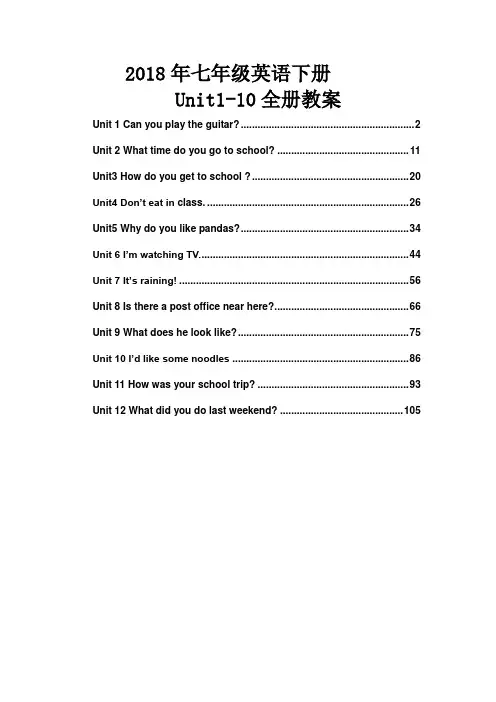
2018年七年级英语下册Unit1-10全册教案Unit 1 Can you play the guitar? (2)Unit 2 What time do you go to school? (11)Unit3 How do you get to school ? (20)Unit4 Don’t eat in class. (26)Unit5 Why do you like pandas? (34)Unit 6 I’m watching TV (44)Unit 7 It’s raining! (56)Unit 8 Is there a post office near here? (66)Unit 9 What does he look like? (75)Unit 10 I’d like some noodles (86)Unit 11 How was your school trip? (93)Unit 12 What did you do last weekend? (105)2018年春七年级英语下册教案Unit 1 Can you play the guitar?一. Knowledge and abilities goals:1.vocabulary:dance,swim,sing,play chess , paint ,speak English, play the guitar2. How to use Model verb‖ can‖.3. Listening and speaking skills and communicative competence.二. Teaching method: Listening and speaking methods. Pair works.三. Moral goals: Encourage students to express their abilities.Content of courses: In this period, students will learn some names of clubs ,such as art , music, chess club, swimming club, etc. students will learn the drills :Do you want to join…club ?Can you …?四. Importance and difficulty: canTeaching Aids: A tape recorder. Some pictures. A projector Some sports things, such as volleyball, basketball, etc. Preparation test paper for lessons before class.五. Teaching Time: 4 periodsPeriod 1 (Section A: 1a-2d)授课人:______ 授课班级: _____ 授课时间:2018年___月___日____午第____节1.Knowledge Objects: Learn to talk about abilities.Know something about the culture of clubs. Can you/he..?What can you do? What club do you want to join?can, can‘t, draw, dance, swim, speak, walk.2.Teaching key point: can3. Teaching Difficult point: can4.Teaching Procedures:Step 1. Lead-inEnjoy a song I’m a musicianT: Do you want to be a musician? S:T: Can you play the piano? S…T: What can you do? S: I can…T: What about you? S:T: OK, now please show your talent and tell us what you can do.Ask one of the students come to the front and do the action. Ask other students to guess what he or she can do.Step 2. PresentationT: Look at the pictures. What are they doing? S:Step 3 Pair workLook at the pictures. Ask and answer like this:A: Can you play basketball?B: Yes, I can. / No, I can‘t.Can you…?Step 4 PresentationShow some pictures of fam ous stars. Practice the third person ―he, she, they‖T: Where can you play chess? S:T: Yes, in a chess club. This term, we have a lot of clubs. What club do you want to join? S…T: Sounds great. Can you…?S: Yes, I can/ No, I can‘tIf the answer is negative, guide students to say:S: No, I can‘t. But I can learn it from others.Step5 Pair workA: What club do you want to join?B: I want to join the…A: Can you …?B: Yes, I can . No, I can‘t. But I can learn it from others.Step 6 ListeningListen to 1bListen to 2a and 2b. Tell them to give special attention to listening activity (names of the clubs). Finish the tasks.Step 7 Pair workLook at 2b and talk about what the people can do the clubs they want to join. Step 7 Role-play the conversation 2dT: If you like telling stories. What club can you join?S: Story telling club.T: Right. Please read the conversation following the recording. Who wants to join the story telling club? Then role-play the conversation.Step 8 Explain some language points.Step 9 HomeworkReflection after class:_____________________________________________________________________ _____________________________________________________________________ _____________________________________________________________________ _________________________________Period 2 (Section A: 3a-3c)授课人:______ 授课班级: _____ 授课时间:2018年___月___日____午第____节1. Knowledge Objects: go on learning to talk about abilities.—Can you play the guitar? —Yes, I can./ No, I can't.—What can you do? —I can dance.—What club do you want to join? —I want to join the chess club.2. Teaching key points: Conclude the usage of ‗can‘; put all new language into practice through different activities.3. Teaching Difficult points: Distinguish ―say, speak, tell, talk‖4.Teaching Procedures:Step1:Greeting, Warming up and duty report.Watch a flash about the content of the Just for fun.Talk something about the flash: Why is the other boy unhappy?Introduce because of the difference of time zones, the time in different places are different.Revision: show the time in six places: Beijing, Tokyo, Paris, Los Angeles, New York, and London. Elicit the sentence pattern: What time is it?It‘s……Draw attention to the ―am‖ and ―pm‖. For instance, Beijing is seven o‘clock in the morning. We can say Beijing is seven am. Los Angeles is three in the afternoon. So we can say Los Angeles is three pm. (teacher helps students answer).Step2:Review the words learnt in the last period and add more.(1)T:Here are some Chinese, let us see what time do they usually get up/ take a shower…get up take a shower eat breakfast go to school eat lunch run go home do homework eat dinner go to bed(2)ask students to make a surveyAsk your friend 5 questions about his /her day. Then make a report.A: What time do you usually…?B: I usually…at…Step3:presentation.(1)Ben‘s day. Introduce something about Ben.Using the sentence pattern: What time does he usually get up/go to school/…Pay attention to the verb form of the third person.Discuss Do you like ben‘;s routines.(2)Show the picture of Scott. He usually gets up at 5 pm.Ask students to predict what his job is?(3)listen to the tape,and try to answer this question. then read through the passage,and match the pictures with the times.(4)read it again and fill in the chart.(5)answer the following questions1.Where does he work?2.How does he go to work?Step4:Work on 3a.(1)Read through the passage and tell me what his job is.(2)Read it again and match the pictures.(3)Answer questions:What does he do after he get up?Does he go to work after breakfast? What does he do?How does he go to work? By bus or on foot?What does he do before he goes to bed?What does―What a funny time to eat breakfast!‖mean?Step5:Follow up.T:My friend Da Bao likes Scott's work, so he gets to Sai Te Hotel . But he doesn't find him.T: There are many children in the hotel. Look, they are coming. Please ask them questions to find the real Scott.Step6:Work on part4.T:Now six people make a group, and ask the other students when they usually go to bed . The leader lines up from the earliest to the latest bedtime.T: Let's listen Group1…Group2…Step7:Work on part 3 of self –check.T: Now I want to know something about what you do on weekends. Y ou can go, ask your classmates and fill in the forms. Then you have a report.T: You may begin it like this "Ma Li gets up at …"Step8:Homework.Oral work:(1)Read 3a and recite it.(2)Go on making a survey to find out what your classmates do on weekends. Reflection after class:_____________________________________________________________________ _____________________________________________________________________ _____________________________________________________________________ _____________________________Period 3 (Section B: 1a-1f)授课人:______ 授课班级: _____ 授课时间:2018年___月___日____午第____节1. Knowledge Objects: go on learning to talk about abilities. drum, play the drum, piano, play the piano, violin, play the violin2. Teaching key points: Improve listening and speaking3. Teaching Difficult points: Improve listening and speaking4. Teaching Procedures:Step 1 Warming- up and revisionDaily greeting.Check the homework. Let some Ss report what his/her family members can do.Step 2 PresentationPlay the sound of different kinds of instruments. Let Ss guess what it is.Act and show your classmates your talent.T: Please stand in front of your classmates. Act and say what you can.S1: (sing and dance) I can sing and dance.S2: (play the drum) I can play the drum..Step 3 ListeningTell the Ss that they will listen to some sounds of the instruments. Listen and number the words [1-4] in the order of the sounds you hear in 1a.Play the recording again and check the answers.T: Now let's work on 1c. First, let one student read the words and phrases aloud.Then listen to the 1d and circle the words and phrase you hear.Check the answers:T: Now please look at the chart in 1e. What can Bill, Cindy and Frank do? What can't they do? You'll listen to the recording again. Then try to fill in the blanks. Step 4 Group workWork in groups. Take turn to talk about what Bill, Cindy and Frank can and can't do.S1: Bill can play the guitar, but he can't sing.S2: Cindy can sing and play the drum, but he can't play the piano.Teacher can walk around the classroom, and give some help to the Ss.Step 5 HomeworkMake up a conversation between a volunteer and a person who is in charge of a sports club/old people‘s home/music club.Reflection after class:_____________________________________________________________________ _____________________________________________________________________ _____________________________________________________________________ ____________________________________Period 4 (Section B: 2a-self check)授课人:______ 授课班级: _____ 授课时间:2018年___月___日____午第____节1. Knowledge Objects: go on learning to talk about abilities. also, people, help (sb) with sth, center, home, today, be good with, make, make friends, weekend, on weekends/on the weekend, teach, musician2. Teaching key points: Also, too; be good with, help with3. Teaching Dif ficult points: Describe one‘s ability4. Teaching Procedures:Step 1 Warming-upCheck the homeworkAsk some pairs to show their conversationsStep 2 ReadingFirst, show some pictures of the boys and girls and some key words in 2a.T: Here are some pictures and information about Peter, Alan and Ma Huan. Can you describe them according to the pictures and key words?S1: Guide Ss to use ―also, too‖, and distinguish how to use these two words. Give comments on Ss‘ descriptions.T: Now we‘ll read thre e ads. What's the main idea of each ad? What's each ad's title? Now let's read the three ads and select a title for each ad. Ss read carefully and try to select a title for each ad. Check the answers with the class. Step 3 Review the usage of ―tell‖,Re view and distinguish the usage and function of ―help‖T: Suppose Peter, Alan and Ma Huan want to help to do something after school. Which ad is right for him/her? Now read the descriptions in 2a and the ads in 2b again. Select a right ad for each person.Ss read the descriptions in 2a and the ads in 2b again. Try to select a right ad for each person. They can talk about the answers in their groups.Check the answers with the class.Step 4 Homework1. Recite 2a and 2b2. Finish the exercise on p6Reflection after class:____________________________________________________________________ Unit 2 What time do you go to school?1. Teaching Aims:1) Aims of Basic Knowledge:①Vocabulary: time, shower, usually, O‘clock, what time, go to schoo l, take ashower.②Grammar: What time do you…? What time does he / she…?③ Function: Use the simple tense to talk about the daily life.2) Aims of Abilities: Listening skill. Speaking skill. Reading skill. Writingskill.3) Aims of Emotion: Love life.2. Analysis of the Material:1) Brief Introduction of the teaching material:What time / When do you…?‖ ― What time / When does he…?‖2) Teaching Focus: What time do you…? What time does he/ she…?3) Teaching Difficulties: Present tense.3. Learning Methods: Make a plan. Culture.4. Teaching Methods: Student- centered. Task-based Teaching.5. Teaching Time: 4 periodsPeriod 1(Section A: 1a-2a)授课人:______ 授课班级: _____ 授课时间:2018年___月___日____午第____节Step One: Warming-upGreetingT: Good afternoon, everyone.Ss: Good afternoon, Miss Yang.Step Two: Presentation1.Adjust the time, and ask students questions.T: What time is it? Ss: It‘s 12 o‘clock. ( Write on Bb )( Help Ss to say )T: What time is it? Ss: It‘s 10:15.( Help Ss to say )2.Ask one student to come to the front, adjust the time and ask the otherstudents.S1: What time is it? Ss: It‘s 9 o‘clock.3.Teach the new words & phrases.Show some pictures of different clocks and the activities.T: I‘m very busy these days. Can you guess what time I get up / eat breakfast / go to school / run / take a shower? ( Write on Bb)T: I usually get up at 6:35. ( Teach Ss the new word ― usually‖ )S1: You usually eat breakfast at …S2: You usually run at…S3: You usually take a shower at …4.Ask Ss to do the exercise of 1a, and then check the answers.Step Three: Listening1.Show Ss the timetable of Rick‘s ( write on small Bb )Rick‘s timetableGets upEats breakfastRunsGoes to schoolTakes a showerAsk Ss listen to the recorder and fill in the chart.Then check the answers.2.Ask and answer.T: What time does Rick get up / eat breakfast / run / go to school / take a shower ?Ss: He gets up / eats breakfast / runs / goes to school / takes a shower at…( Ask Ss pay attention to the underlined phrases.)Step Four: Consolidation1.Ask Ss to look at the pictures and tell their days.Example: I usually get up at …. I eat breakfast at …. I go to s chool at …. At …, I take a shower.Step Six: Homework1.Try to remember all the words & phrases.2.Survey: Ask your classmates their routines, and give your report.3.Plan: January 1st is coming. Please plan it, and make your daywonderful.Step Seven Blackboard DesignUnit 2 What time do you go to school?What time do you go to school? I usually go to school at six thirty.go to school get dressed get up brush teetheat breakfast take a shower what timeReflection after class:_____________________________________________________________________ _____________________________________________________________________ _____________________________________________________________________ _______________________Period 2 (Section A: 2b-Grammar Focus)授课人:______ 授课班级: _____ 授课时间:2018年___月___日____午第____节1. Aims and demands :1) Language skills :Ss learn to talk about kinds of transportation, and how long it takes to go places, and how far apart places are.2) Target Language : Words : how far , get to , bicycle , subway , bus stop, train station , minute, kilometer, mile , transportation , calendarSentences: How do you get to school ? / How long does it take ? / How far is it ?3) Moral object : Through learning this unit , Ss can enable them to care for each other whenever crossing the roads and pay attention to the sign of traffic. 2. Analysis of the material:Students have learned the transportation before.. In this unit ,they need to learn more details about the transportation. At the same time ,they need to learn ―How long and How far‖ and they can use them freely.3. Teaching methods:pairwork , groupwork ,listening and speaking, practicing4, learning strategies:Personalizing Inferring vocabulary5.Teaching aids:Tape recorder, a projector or a computer6.Teaching period:Four periods.Period 3 (Section B: 3a-3c)授课人:______ 授课班级: _____ 授课时间:2018年___月___日____午第____节1. Aims and Demands: Key vocabulary, How do you get to school ? How does heget to school ?2. Teaching methods : Listening Writing Pairwork3. Teaching Aids : A tape recorder.Step I Leading inT: Good morning, everyone! You know I live far away ,so I go to school by bus every day. What about you? David, ―How often do you go to school?‖S:--------T: So we will talk about how to get to places in this unit.Step IINow I will show you pic tures and let‘s review the transportations we know. Then we will learn more about it .(take the subway) Please open your books and finish 1a.Step III1. There are five names in 1b.Now they are in the picture. We should find them.2. Play the tape .They should listen carefully and find the persons .Write the numbers next to the correct students in the picture above. After listening , check the answers together .Step IVPoint to the example in the box , ask two students to read it .then ask them to make up their conversations about how the people in the picture get to school . Teacher choose some pairs to act their conversations.Step VPracticing the listening :T: I will play two conversations The people are talking about how students get to school and how long it takes .The first time check the kinds of transportation that you hear. The second time match the time with the kinds of transportation activity 2a.Step VI1. Pay attention to the picture and dialogue.2. Make your own dialogue into pairs.3. Act it in front of the students.Step VIISummary and homework: This class we have learnt some key vocabulary and the target language .I hope after class you can survey how does your friends get to school .and pre-revise the 3a,3b.Step VIII Blackboard DesignUnit 4 How do you get to school ?How do you get to school ?How long does it take ?It takes about 10 minutes .Reflection after class:_____________________________________________________________________ _____________________________________________________________________ _____________________________________________________________________ __________________________________Period 4授课人:______ 授课班级: _____ 授课时间:2018年___月___日____午第____节课题Unit 2 What time do you go to school?(第4课时)教学批注教学设计一、教学三维目标1.知识与技能:(1)通过本单元的学习,使学生掌握相关的时间表达方法以及相关的词汇,能够就生活中的时间安排及日常活动来交谈;(2)通过情景设计来激发学生学习的学习兴趣,并培养学生的自主学习和与他人合作的精神;(3)通过谈论作息时间及日常活动,培养学生合理安排作息时间的意识。
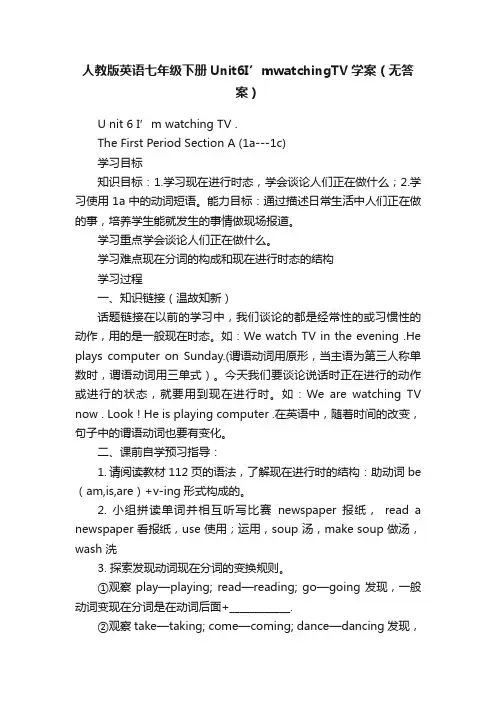
人教版英语七年级下册Unit6I’mwatchingTV学案(无答案)U nit 6 I’m watching TV .The First Period Section A (1a---1c)学习目标知识目标:1.学习现在进行时态,学会谈论人们正在做什么;2.学习使用1a中的动词短语。
能力目标:通过描述日常生活中人们正在做的事,培养学生能就发生的事情做现场报道。
学习重点学会谈论人们正在做什么。
学习难点现在分词的构成和现在进行时态的结构学习过程一、知识链接(温故知新)话题链接在以前的学习中,我们谈论的都是经常性的或习惯性的动作,用的是一般现在时态。
如:We watch TV in the evening .He plays computer on Sunday.(谓语动词用原形,当主语为第三人称单数时,谓语动词用三单式)。
今天我们要谈论说话时正在进行的动作或进行的状态,就要用到现在进行时。
如:We are watching TV now . Look ! He is playing computer .在英语中,随着时间的改变,句子中的谓语动词也要有变化。
二、课前自学预习指导:1. 请阅读教材112页的语法,了解现在进行时的结构:助动词be (am,is,are)+v-ing形式构成的。
2. 小组拼读单词并相互听写比赛newspaper 报纸,read a newspaper 看报纸,use 使用;运用,soup 汤,make soup 做汤,wash 洗3. 探索发现动词现在分词的变换规则。
①观察play—playing; read—reading; go—going发现,一般动词变现在分词是在动词后面+____________.②观察take—taking; come—coming; dance—dancing发现,以e结尾的动词变现在分词要___________________________.③观察run—running; begin—beginning; get—getting发现以重读闭音节结尾的单词,且词尾只有一个辅音字母变现在分词应_________________________________.④观察study—studying; fly—flying发现,以字母+ 结尾的动词变现在分词是_____________________________________.尝试练习:读下列动词,翻译并试着写出动词的-ing形式do()_________read()_________watch()_________ talk()_________ clean()_________wash()________listen()________use ()_________ make()_________ run()_________exercise()_________go()_________ 2. 预习1a并翻译其中短语看电视______ ___在电话中交谈____ _____ 看报____ _____ 听CD___ ______使用电脑做汤洗餐具温馨提示:英语中“看”法各异。
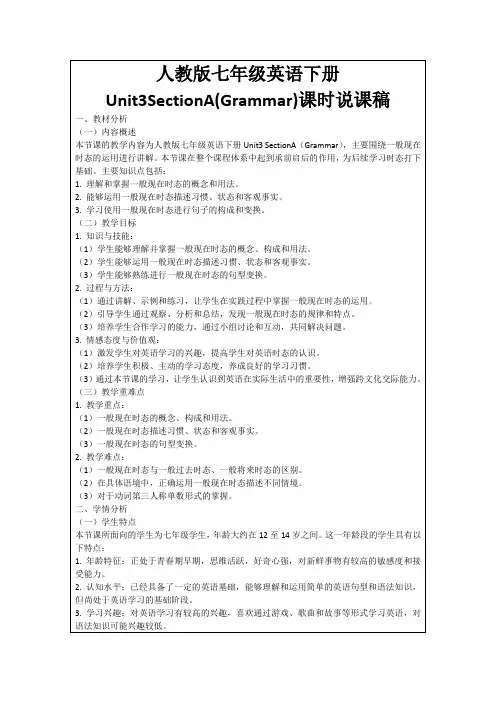
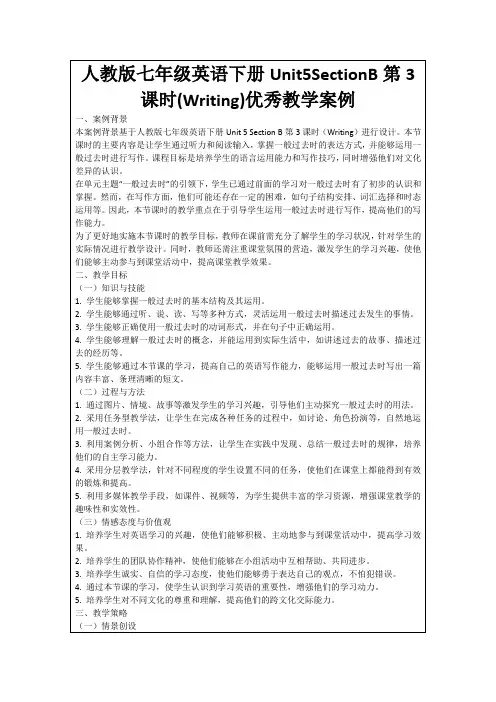


人教版2018七年级英语下册第五单元复习学案人教版2018七年级英语下册第五单元复习学案Unit5 I'm watching TV.Section A一、Teacher's words: Where there is a will, there is a way.二、Teaching aims:1.知识目标:词汇: clean, read, sure, wait, toy, west, camera, activity, shop, bird.短语:talk about, a photo of, thanks for, play soccer, wait for, some of, in the first photo, …交际用语:(1)-- What are you doing? --I'm watching TV. (2)-- Is Nancy doing homework? --No,she isn't. She's writinga letter.(3 ) --Do you want to go to the movies? --Yes,I do.(4.)--When do you want to go? --Let's go at 7:00.语法:现在进行时的用法。
2. 能力目标:学会谈论人们正在做什么,学会写英文信,能就现场发生的事作现场报道。
3 .情感目标:通过合作学习谈论正在发生的事,启发学生思维,培养学生的合作精神。
三、教学重点:"教学目标"中的"知识目标"和"能力目标"。
教学难点:"现在进行时"的应用。
四、Teaching course:Step 1.预习导学自测:根据句意补全已给出首字母的单词:1、My little brother is w_____ a letter.2、The students are c_____ the classroom.3、The boy is taking a photo with a c______.4、Are they w_____ for a bus over there?5、He's r_____ a newspaper.小小翻译家:1、talk about________2、a photo of________3、wait for________4、in the first photo________5、电话交谈________6、踢足球________7、因…而感谢________ 8、许多图书馆_______Step2 情境导入Look at the pictures in P25 1a and write sentencesNow it's 6:00 pm. What are they doing?In picture A. She is talking on the phone.In picture B. ________________________In picture C. ________________________In picture D. ________________________In picture E. ________________________In picture F. ________________________Step3 自主探究1.以上练习的句子是什么时态?_______________________________.2.该时态的结构是_________________________________________.3.现在分词的构成规则A、一般直接在动词后加______ ,如reading,watch_____, talk____ . B、以字母不发音的e 结尾的____________,如writing,come_______, make ____ .C、一个元音字母加一个辅音字母结尾且末尾只有一个辅音字母的重读闭音节词要_____________________ 。
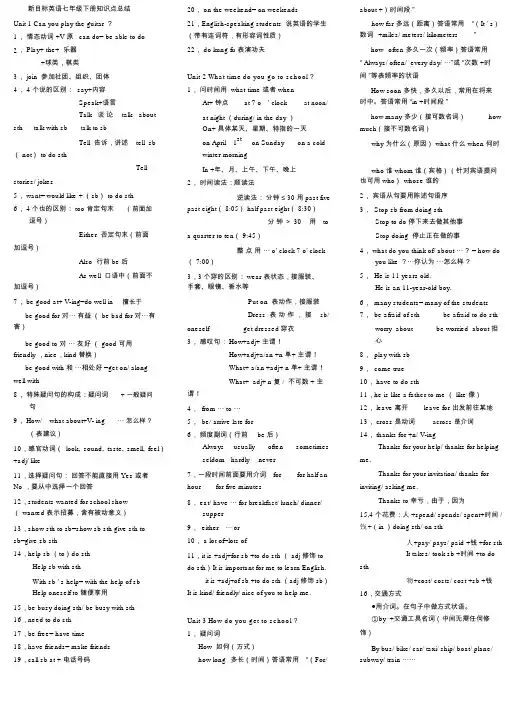
新目标英语七年级下册知识点总结Unit 1 Can you play the guitar ?1,情态动词 +V 原 can do= be able to do2, Play+ the+ 乐器+球类,棋类3, join 参加社团、组织、团体4, 4 个说的区别: say+内容Speak+语言Talk谈论talk about sth talk with sb talk to sbTell 告诉,讲述tell sb( not) to do sthTell stories/ jokes5, want= would like + (sb) to do sth6, 4 个也的区别: too 肯定句末(前面加逗号)Either 否定句末(前面加逗号)Also 行前 be 后As well 口语中(前面不加逗号)7, be good at+ V-ing=do well in擅长于be good for 对⋯有益( be bad for 对⋯有害)be good to 对⋯友好( good 可用friendly ,nice,kind 替换)be good with 和⋯相处好 =get on/ alongwell with8,特殊疑问句的构成:疑问词+ 一般疑问句9, How/ what about+V- ing⋯怎么样?(表建议)10,感官动词(look, sound, taste, smell, feel)+adj/ like11,选择疑问句:回答不能直接用 Yes 或者No ,要从中选择一个回答12,students wanted for school show( wanted 表示招募,含有被动意义)13,show sth to sb=show sb sth give sth tosb=give sb sth14,help sb (to)do sthHelp sb with sthWith sb ’ s help= with the help of sbHelp oneself to 随便享用15,be busy doing sth/ be busy with sth16,need to do sth17,be free= have time18,have friends= make friends19,call sb at + 电话号码20, on the weekend= on weekends21,English-speaking students 说英语的学生(带有连词符,有形容词性质)22, do kung fu 表演功夫Unit 2 What time do you go to school?1,问时间用 what time 或者 whenAt+ 钟点at 7 o’ clock at noon/at night (during/ in the day )On+ 具体某天、星期、特指的一天on April 1st on Sunday on a coldwinter morningIn +年、月、上午、下午、晚上2,时间读法:顺读法逆读法:分钟≤ 30 用 past fivepast eight( 8:05) half past eight( 8:30)分钟> 30用toa quarter to ten( 9:45)整点用⋯ o’ clock 7 o’ clock( 7:00)3,3 个穿的区别: wear 表状态,接服装、手套、眼镜、香水等Put on 表动作,接服装Dress 表动作,接sb/oneself get dressed穿衣3,感叹句: How+adj+ 主谓!How+adj+a/an +n 单+ 主谓!What+ a/an +adj+ n 单+ 主谓!What+ adj+ n 复 / 不可数 + 主谓!4, from ⋯ to ⋯5, be/ arrive late for6,频度副词(行前be 后)Always usually often sometimesseldom hardly never7,一段时间前面要用介词for for half anhour for five minutes8, eat/ have ⋯ for breakfast/ lunch/ dinner/supper9, either⋯or10, a lot of=lots of11,it is +adj+for sb +to do sth ( adj 修饰 todo sth)It is important for me to learn English.it is +adj+of sb +to do sth (adj 修饰 sb)It is kind/ friendly/ nice of you to help me.Unit 3 How do you get to school?1,疑问词How 如何(方式)how long多长(时间)答语常用“(For/about +)时间段”how far 多远(距离)答语常用“(It’ s)数词+miles/ meters/ kilometers”how often 多久一次(频率)答语常用“ Always/ often/ every day/ ⋯”或“次数 +时间”等表频率的状语How soon 多快,多久以后,常用在将来时中。

七年级下册Unit 11 How was your school trip?写作教学案(教师使用)【话题】学校组织的游览活动(School trips)【写作目标】能运用本单元所学的语法(一般过去时态)及语言材料,完成写作描述过去发生的事情。
【课前任务】一、写出下列短语。
1、给奶牛挤牛奶2、骑马3、许多4、在乡下5、总的说来6、对……感兴趣7、消防站参考答案:1. milk a cow 2. ride a horse 3. quite a lot(of…) 4. in the countryside 5. all in all 6. be interested in 7. fire station二、根据汉语意思完成下列句子。
1、卡罗尔拍照了吗?________ Carol ________ ________ photos?2、那真是蛮好玩的。
It ________ ________ ________ fun.3、总之,这是令人兴奋的一天。
All ________ ________, it ________ an exciting day.4、我一点都不喜欢这次行程。
I ________ ________ the trip at ________.5、你在农村学习优秀的东西吗?Did you learn ________ ________ in the countryside?参考答案:1. Did; take; any 2.was; so; much 3. in; all; was 4.didn’t;like;all 5.anything excellent三、写出与本话题有关的词汇和句型。
常用词汇:anything, feed, trip, learned, countryside, interestedfeed … to, quite a lot, all in all, be interested in经典句型:Did you learn anything?I fed the chicken with my grandpa.How was your school trip?They learned a lot about farming.What was your last school trip like?【课中任务】读写结合一、A. 信息归纳阅读下面短文,然后按照项目要求填写所缺信息。
【⼈教版】2017-2018学年七年级英语上册:全⼀册学案(含答案)Starter Unit 1 Good morning!Period One学习⽬标1.掌握字母表中的前8个字母:Aa,Bb,Cc,Dd,Ee,Ff,Gg,Hh2.掌握8个⼈名:快乐⾃学1.我懂得早上见⾯打招呼的句型了。
2. I can read .(我会读)我会跟着磁带⼤声朗读1a中的句⼦。
3. I can write .(我会写)我会⽤拼⾳写我⾃⼰的名字了合作探究⼩组讨论:1.英语中字母的⼤⼩写在格式、笔画等⽅⾯应注意哪些?2.在⽇常⽣活中,遇到过哪些英⽂字母?课堂⼩结这节课我学会了:1.问候的句⼦2.怎样写⾃⼰的英⽂名字达标检测I.写出下列字母的左邻右舍b E g C D f II..你认识下⾯名字吗?将它们搭配在⼀起1.Alice2.Helen3.Bob4.Frank5.Cindy6.Dale7.GraceB.艾丽斯C.海伦D.⾟迪E.弗兰克F.埃⾥克G.格雷丝H.鲍勃III.从II栏中找出与I栏相应的答句I II( )1.Good morning! A.Good evening! ( )2.Hi, Ann! B.Good morning!( )3.Good afternoon! C.Hi, Tom! ( )4.Good evening! D.Good afternoon! IV.补全对话1.-________________, Helen!-Good morning, Cindy!2.-Hi, Bob.-________________, Alice.3.-Good evening!-_______________!V.单项选择( )1.早上或上午见⾯说:“_______”A.Good morning!B.Good afternoon!C.Good evening!( )2.熟⼈之间打招呼时应说:“_______”A.Hi!B.Good morning!C.Good afternoon!( )3.傍晚遇见你的好朋友说:“_______”A.Good morning!B.Hi!C.Good evening!B.Good morning, Eric!C.Good evening, Eric! 学习反思答案:I. a b c D E F f g h B C D C D E e f gII.1-8. BCHEDAGFIII.1-4.BCDAIV.1. Good morning2.Hello/Hi3. Good eveningV.1-4.AACAStarter Unit 1 Good morning!Period Two学习⽬标1.掌握字母表中的前8个字母:Aa ,Bb ,Cc ,Dd ,Ee ,Ff ,Gg ,Hh2.掌握3个新单词:HB ,CD ,BBC快乐⾃学1. I can listen .(我会听)我会听录⾳并跟读2a2. I can finish .(我会完成)我能根据2b 听录⾳,根据所听到的顺序为字母编号。
Unit 8Is there a post office near here?第一课时Section A(1a-2d)Target Navigation【目标导航】Key words and phrases:post,office,police,hotel,restaurant,bank,hospital,street,pay,near,across,front,behind,town,around,post office,police station,pay phone,across from,in front of Key sentences:(1)—Is there a…near here?—Yes,there is.It's…(2)The pay phone is across from the library.(3)The pay phone is between the post office and the library.Skills:学会在街上问路和指路的表达。
Emotion:学会用简单英语句子谈论地点。
培养学生学习英语的兴趣。
The guidance of learning methods【学法指导】让学生围绕着课堂任务在小组中分工合作,在活动中相互探讨、相互交流、相互合作。
Learning important and difficult points【学习重难点】1.学会本课时新单词。
2.There be句型及简单方位词的用法。
Teaching Steps【教学过程】Autonomous Learning Scheme【自主学习方案】预习指导与检测(一)预习指导1.预习1a-2d中的生词,根据音标会读、知道汉语意思;2.朗读1a中的短语、句型,能英汉互译。
(二)预习检测Ⅰ.汉译英。
1.邮局________ 2.警察局________3.餐馆________ 4.旅馆________5.街道________ 6.公园________7.银行________ 8.医院________9.在这附近________ 10.付费电话________(Keys:1.post office,2.police station,3.restaurant,4.hotel,5.street,6.park,7.bank,8.hospital,9.near here,10.pay phone)Ⅱ.完成书中第43页1a的练习。
七年级英语下册教案Unit 1 Can you play the guitar?Section A (1a-2d)1.板书课题:Unit 1 Can you play the guitar?Section A (1a-2d)教学过程1、第一次“先学后教”:(认读词汇、记汉语意思和校正发音。
)(1)、出示学习指导1) 能掌握以下单词:(能做到四会)guitar, sing, swim, dance, chess, play chess, draw, speak, speak Englis h, join, club…(2)、先学。
1、学生根据自己掌握的语音知识,认读英语单词并记住汉语意思。
2、学生听单词录音,画出自己读错的或不会读的单词。
(3)、后教。
教师播放单词录音,学生跟读,校正自己的发音,对于难以记忆的单词,教师指导学生根据字母组合、发音要领寻找规律,进行记忆。
有必要时教师写在黑板上让学生记住并积累字母组合的发音。
(4)、当堂训练1)、单词默写训练、开火车拼读单词训练。
2)、S s look at the picture in 1a. Then read the words and phrases. Let Ss match the activities with the people. Then Check the answers with the class together.3)、. Presentation出示一些反映各种活动的图片、幻灯片或播放课件,引导学生谈论活动:He/She can dance/swim/sing/"··But I can’t dance/swim/sing/...等,学习表达活动的动词短语。
4)、Game (What can I do?)T: Tell your partners what you can do. For example:I can play the guitar. I can sing and dance.Ss work in groups. The let some Ss talk to their classmates in front of the class.2、第二次“先学后教”:(听录音,理解课文大意)(!)、出示自学指导。
1)、用最快的速度大概的看看听力题,对题的容有一点了解。
2)、仔细听录音能听懂录音容并独立完成填序号题和填空题。
(2)、先学。
1、根据学情,适当增加或减少录音播放次数。
2、学生听录音,并回答浅层次问题。
(3)、后教!)能了解以下语法:情态动词can的用法和want to do sth.的用法。
2)、教师公布答案,学生同桌相互改,教师统计学生的自学结果。
(分优、良、差)3)、积极鼓励后进生回答,出现问题学生更正。
4)、难度较大通过讨论仍解决不了的问题,教师通过启发诱导进行点拔解决,并板书于黑板。
Listening1. T: Now let’s listen to the tape, find out the right conversation, and number them 1-3.(播放lb部分的录音让学生听,引导学生根据所听到的容,选出对话的顺序,完成1b部分的教学任务。
)2. Check the answers: (3, 2, 1 ). Pair work1.Ask the Ss to practice the conversations in 1b with a partner. Then make their ownconversations.(引导学生展开Pairwork活动,完成lc部分口语交际的教学任务,学会运用can询问和表达能力。
). Listening1. Work on 2a;T: Now, look at the pictures on P2, listen to the four conversations. Just listen.(Play the recording for the first time, students only listen carefully.)Then, listen to the recording again, and circle the clubs you hear.Check the answers with the class.2. Work on 2b;引导学生根据对话容用正确的单词填空,补全对话,再播放听力材料一遍。
让学生进行校对,练习听力和写作能力,完成2b部分的教学任务。
Check the answers with the Ss.(4)当堂训练。
1. Look at 2b and talk about what the people can do and the clubs they want to join.老师可以和一名优秀的学生做一个对话的例子,让学生们明白如何去问答,例如:T: What club does Lisa want to join?S1: She wants to join the chess club.T: Can she play chess?S1: No, she can't.2. Ss work in pairs to practice asking and answer about Lisa, Bob and Mary.3. Ask some pairs to act out their conversations.3、第三次“先学后教”(学生读默读或朗读课文,勾出不认识的单词、短语及句句型,读后回答问题。
)(1)、出示学习指导1)、用最快的速度朗读课文,理解课文大意,勾出不理解的短语,或语言点及语法结构。
能掌握以下句型:2)、①—Can you play the guitar? —Yes, I can./ No, I can't.②—What can you do? —I can dance.③—What club do you want to join? —I want to join the chess club.3)用最快的速度朗读课文,理解课文大意,勾出不理解的短语,或语言点及语法结构。
4)回答课文相关问题。
(2)、先学。
1、学生读短文,教师密切关注学生的自读情况,进行行间巡视。
2、画出不懂得语言点、表达方式和语法现象。
(3)、后教。
1)、学习询问和谈论彼此的能力和特长;2) 掌握一些弹奏乐器的表达方式。
3、学生自学后回答理解性问题。
4、对学生不会的,通过启发诱导的方式让学生理解。
5、学生难以理解的短语、句型或者语言点,适当点拔、举例、归纳等,并板书。
(4)、当堂训练1、口述课文容。
2、分角色朗读课文。
3、围绕本节课讲的语法项目,设计当堂训练题目。
. Role-play1. Ask Ss to look at the picture in 2d. Then Ss read the dialogue by themselves and try tofind out the answers to these questions.①What club does Bob join?②What club does Jane join?Ss read the conversation by themselves and find the answers to the questions. Then check the answers:①Bob joins the soccer club. ②Jane joins the English and art club.2. Explain something that Ss can't understand.3. Let Ss read after the teacher or play the recording and let Ss read after the recording.4. Ss work in pairs to act out the conversation.5. Ask some pairs come to the front of the classroom. They try to act out the conversation. See which group is the best.一、第一次先学后教.(Grammar Focus.)1、出示学习指导。
1) 继续练习运用情态动词can。
学会询问和谈论彼此的能力和特长。
2)能够学会使用情态动词can的疑问句以及它的肯定句和否定句。
2、先学。
(1)让学生自己先读语法焦点,并找出语法结构。
老师将情态动词的can的用法,以学案的方式呈现在大屏幕上,让学生自主学习,并发现其用法。
(2)可以看出,在Can…?句型中,情态动词can没有________和_______ 的变化。
(3)用情态动词can来询问他人的能力可以归纳为以下句型:Can + _______ + _________ + 其他?肯定回答:_________________否定回答:_________________What + can + _______ + ________ ?学生们合作学习讨论上面学案的答案,总结情态动词can的用法。
老师找部分学生对上述问题作答,并一起讨论总结情态动词can的用法。
3、后教。
(1)、教师公布答案看谁做对的最多,分析出学生对题掌握的程度。
(2)教师把重要的语法结构写在黑板上,让学生学会思考,并做对比,区分语法结构上的变化。
(3)教师讲解can 后面的动词用动词原形部分人称变化。
4、当堂训练(1). Ask some Ss about their abilities.T: Hi, S1! What can you do?S1: I can sing and dance?T: Can you play the guitar?S1: Sorry, I can't. But I can play chess.T: What club do you want to join?S1: I want to join the chess club.(2.)Role-play.Let some pairs role play the conversation in 2c.1. 阅读指导:2. 学生阅读Grammar Focus中的句子,然后做填空练习。
①你会游泳吗?______ you ______?②是的,我会。